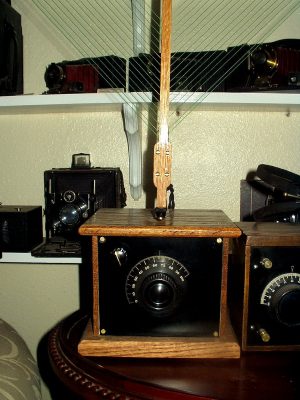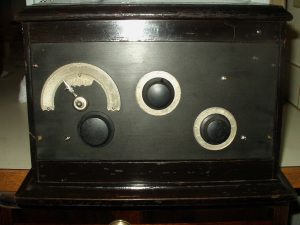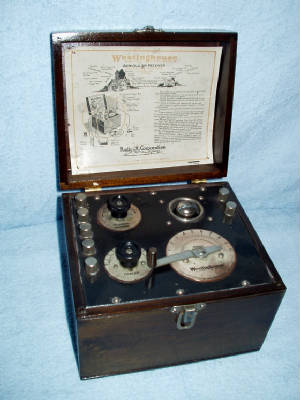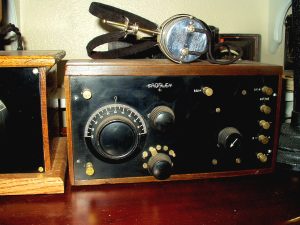|

Here's a closeup of the antenna I built using nothing more than a hand saw, sandpaper, clamps, glue, screws, and
a cheap cordless drill. Tried to make it look like a real 1920's antenna (email me and tell me how I did).
One of these days, I'll build one using real power tools! Uses a Pilot 550mmf brass tuning condenser, a dial knob and
2 small knobs from a 1920's radio, brass binding posts, and litz wire Works as well as my 65 ft long wire antenna,
and in addition, is directional.

A 1924 Crosley model 51 super deluxe, 2 tube regenerative receiver. A deluxe version of the model 51 listed
above. Note that this version does not have a tap switch. This version uses a more conventional vaned tuning capacitor
with more (and sharper) band-spread instead of the book-type which is more narrow and coarse. Worked when I got
it (very few of these model radios out there are not working, they are so simple)
|
 |
|

My little Westinghouse Aeriola Senior, one tube regenerative receiver, ca. 1921. Uses a single WD-11 triode tube
and batteries. Actually works quite well, considering how simple it is (uses 1 tube with socket, 1 multi-wound coil
with 2 variometers, 3 fixed capacitors, 1 resistor, and a few wires). This one is the early version with
the wood faceplate. These little radios were one of the first mass-produced tube receivers. This is one of my
many favorites! The radio collectors out there are fighting over these things.
|
 |
|
|
 |
|

A 1924 Crosley model 51, 2 tube regenerative receiver. Not very big or very complicated, this set works very well
and is easy to use. There is even enough power to drive an external speaker for local stations. An amplifier for
this set was also available (although I don't have one yet) that would supply enough power for very distant stations.
This little inexpensive radio spelled the beginning of the end for the more expensive sets made by such names as Atwater-Kent,
Freed-Eisemann, Kolster, Kennedy, Pfanstiehl, Neutrowound, Music Master, Browning-Drake, to name a very few. By the
end of the Great Depression, nearly 80% of all radio manufacturers would be gone, and this little guy is one of the sets that
would be responsible.
|
|

